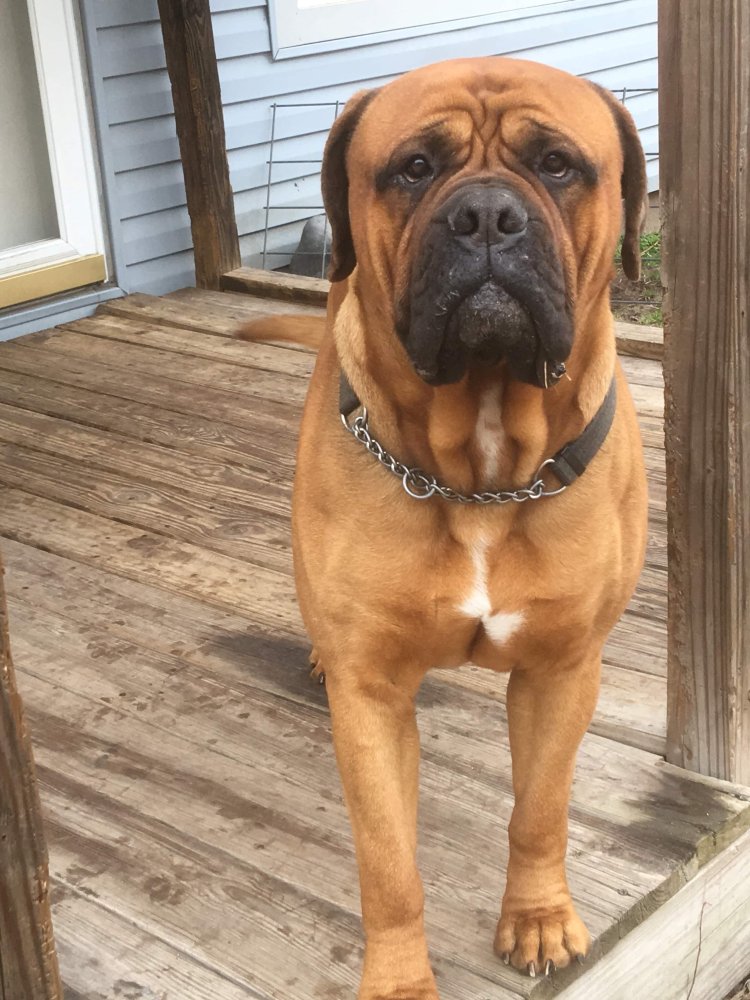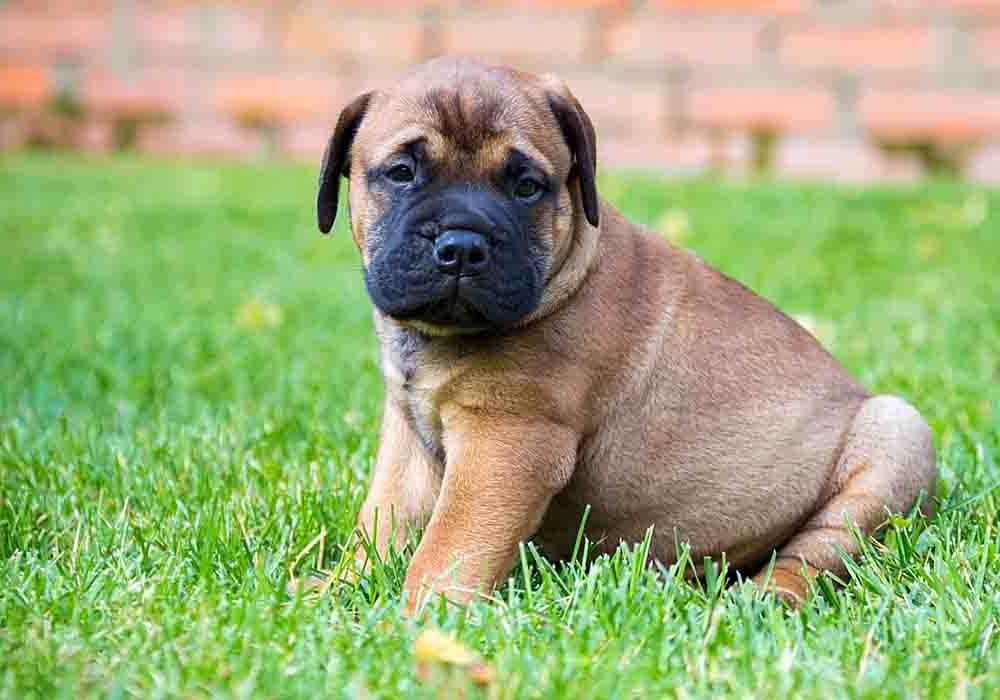- Breed Category: Working Group
- Country of Origin: United Kingdom
- Average Height: Males 64-69 cm, Females 61-66 cm
- Average Weight: Males 50-59 kg, Females 45-54 kg
- Average Life Span: 8-10 years
- Grooming Requirements: Low, occasional brushing
- Exercise Requirements: Moderate, daily walks
- Coat Type: Short and dense
- Coat Color Variations: Fawn, red, brindle
- Shedding Level: Moderate
- Ear Type: V-shaped, folded
- Tail Type: Straight, set high
- Temperament: Loyal, protective, calm
- Intelligence Level: High
- Barking Tendency: Low
- Compatibility with Children: High, very good
- Compatibility with Other Pets: Moderate, needs socialisation
- Training Ease: Moderate, firm handling needed
- Common Health Issues: Hip dysplasia, bloat
- Dietary Needs: High-quality, balanced diet
- Energy Level: Moderate
- Drooling Tendency: High
- Sensitivity to Weather: Sensitive to heat
- Overall Maintenance Level: Moderate
- Original Purpose: Guarding estates
- Year of Recognition by Kennel Clubs: 1924
- Apartment Friendly: Yes, with sufficient exercise
- Best Suited For: Families, experienced owners
- Cost of Ownership: Moderate to high
- Unique Traits: Strong protective instincts
- Popularity Rank: Moderate
Imagine a dog that combines the strength of a lion with the gentle nature of a lamb. That’s the Bull Mastiff for you. Known for their impressive size and loyal temperament, Bull Mastiffs are a unique blend of power and affection. Originally bred in England during the 19th century, these dogs were designed to guard estates against poachers. Their history is as rich as their character, making them fascinating companions. This article aims to delve into the Bull Mastiff’s distinctive traits, explore their storied past, and offer insights into their care. Whether you’re considering adding one to your family or simply curious, understanding this breed will surely deepen your appreciation for these gentle giants.
History and Origin of the Bull Mastiff

Early Development of the Breed
The Bull Mastiff’s journey began in the 19th century in England. Gamekeepers needed a dog that was both powerful and stealthy to protect estates from poachers. By crossing the English Mastiff with the Bulldog, they created the Bull Mastiff. This blend resulted in a dog that was not only strong and agile but also had a keen sense of loyalty and protection.
Role in Guarding Estates and Properties
These dogs were the silent sentinels of the night, bred to track and pin down intruders without causing harm. Their imposing presence and fearless nature made them perfect for guarding large estates. They were trained to work quietly, relying on their strength and intelligence to deter any threats.
Key Historical Figures Involved in the Breed’s Creation
Key figures in the development of the Bull Mastiff include gamekeepers and breeders who recognised the need for a reliable guard dog. Their efforts in selectively breeding these dogs ensured the Bull Mastiff became the ultimate protector, a role they still excel in today.
Physical Characteristics of the Bull Mastiff

Appearance
Bull Mastiffs are truly impressive in size, often weighing between 50 to 60 kilograms. Their coat is short and dense, coming in shades of fawn, red, or brindle. These colours often feature a distinctive black mask around the face, adding to their striking appearance. Their eyes are dark and expressive, giving them a thoughtful look that complements their gentle nature.
Unique Physical Traits
One of the most notable features of the Bull Mastiff is their powerful build. They have a broad head and a muscular body, which speaks to their strength and agility. Despite their size, they move with surprising grace. Their strong neck and deep chest are balanced by a sturdy frame, making them both formidable and elegant. This combination of power and poise is what sets the Bull Mastiff apart from other breeds.
Temperament and Behaviour of the Bull Mastiff

Typical Personality Traits
Bull Mastiffs are known for their loyalty and protectiveness. They have a calm demeanour that makes them excellent companions. Despite their imposing size, they are gentle giants at heart. Their loyalty is unmatched, and they are always ready to stand by their family, making them reliable protectors.
Suitability as a Family Pet and Guard Dog
These dogs are well-suited for families, offering both companionship and security. Their natural guarding instincts make them excellent watchdogs, while their affectionate nature ensures they fit right into family life. They are vigilant without being aggressive, striking a perfect balance between being a family pet and a guard dog.
Interaction with Children and Other Animals
Bull Mastiffs are generally good with children, showing patience and gentleness. They can be protective of the little ones, often forming strong bonds. When it comes to other animals, early socialisation is key. With proper introduction, they can coexist peacefully with other pets, though their size and strength should always be considered during interactions.
Training and Exercise Needs of the Bull Mastiff

Importance of Early Training and Socialisation
Getting a Bull Mastiff started on training and socialisation early is crucial. These dogs are naturally protective, so introducing them to different people, environments, and other animals when they’re young helps them grow into well-rounded adults. Early exposure ensures they remain calm and confident in various situations, making them better companions and guardians.
Recommended Training Techniques
When it comes to training, consistency and patience are key. Positive reinforcement works wonders with Bull Mastiffs. They respond well to treats, praise, and playtime as rewards. Keep training sessions short and engaging to hold their attention. Remember, these dogs are intelligent and eager to please, so a gentle yet firm approach will yield the best results.
Daily Exercise Requirements and Activities They Enjoy
Despite their size, Bull Mastiffs don’t need excessive exercise. A couple of short walks and some playtime in the yard each day will keep them happy and healthy. They enjoy activities that engage their minds, like puzzle toys or obedience games. Just be mindful of their joints and avoid over-exertion, especially when they’re young and still growing.
Health and Lifespan of the Bull Mastiff

Common Health Issues
Bull Mastiffs, like many large breeds, can face specific health challenges. Hip and elbow dysplasia are common, given their size and weight. They may also experience bloat, a serious condition that requires immediate attention. Eye issues, such as entropion, can occur, and some may develop heart problems. Regular vet check-ups are essential to catch any issues early.
Average Lifespan and Health Tips
On average, Bull Mastiffs live between 7 to 10 years. To help them reach the upper end of this range, a balanced diet and regular exercise are crucial. Keep their weight in check to reduce stress on their joints. Mental stimulation is just as important, so engage them with interactive toys and training sessions.
Preventative Care Recommendations
- Schedule regular veterinary visits for health screenings and vaccinations.
- Maintain a healthy diet tailored to their age and activity level.
- Provide joint supplements if recommended by your vet.
- Ensure they have a comfortable sleeping area to support their joints.
- Brush their teeth regularly to prevent dental issues.
Grooming and Maintenance of the Bull Mastiff

Coat Care and Grooming Routines
Keeping a Bull Mastiff’s coat in top condition is pretty straightforward. Their short, dense coat doesn’t require extensive grooming, but regular brushing helps keep it looking its best. A weekly brush with a rubber grooming mitt or a bristle brush will remove loose hair and distribute natural oils, keeping their coat shiny and healthy.
Shedding and Seasonal Grooming Tips
While Bull Mastiffs are not heavy shedders, they do experience seasonal shedding, usually in spring and autumn. During these times, you might want to increase brushing to a few times a week to manage the extra hair. A good bath every couple of months or when they get particularly dirty will also help keep their coat clean and fresh.
Don’t forget to check their ears regularly for any signs of infection and keep their nails trimmed to a comfortable length. Regular grooming not only keeps them looking good but also provides an opportunity to check for any skin issues or parasites.
Diet and Nutrition for Bull Mastiffs

Nutritional Needs for Optimal Health
Feeding a Bull Mastiff isn’t just about filling a bowl. It’s about ensuring they get the right nutrients to support their size and energy levels. A balanced diet rich in high-quality proteins, healthy fats, and essential vitamins is crucial. Proteins help maintain their muscle mass, while fats provide the energy they need for their daily activities.
Foods to Include and Avoid
Include lean meats like chicken or beef, along with fish for omega-3 fatty acids. Whole grains and vegetables can provide necessary fibre and nutrients. Avoid foods high in fillers, artificial additives, and excessive fats, as these can lead to obesity and other health issues. Always steer clear of chocolate, onions, and grapes, as these are toxic to dogs.
Feeding Schedules and Portion Recommendations
Establishing a regular feeding schedule helps maintain their digestive health. Typically, two meals a day are sufficient for adult Bull Mastiffs. Puppies may require more frequent, smaller meals. Portion sizes depend on their age, weight, and activity level, so it’s wise to consult with a vet to tailor their diet accordingly. Keep an eye on their weight to adjust portions as needed.
Fun Facts and Trivia about Bull Mastiffs
Interesting Tidbits about the Breed
Bull Mastiffs are often called the “Gamekeeper’s Night Dog” due to their historical role in protecting estates. Despite their size, they are surprisingly agile and can move quietly, a trait that was essential for their original purpose. They have a unique ability to track scents, making them excellent at locating intruders without causing harm.
Another fun fact is that Bull Mastiffs are known for their distinctive black mask, which adds to their striking appearance. This feature is not just for looks; it was believed to help them blend into the night while on duty.
Famous Bull Mastiffs in Media or History
In the world of media, Bull Mastiffs have made their mark too. One of the most famous Bull Mastiffs is “Butkus,” the beloved pet of actor Sylvester Stallone, who appeared in the original “Rocky” film. Butkus was not just a movie star; he was Stallone’s real-life companion during his early career struggles.
In history, Bull Mastiffs have been associated with royalty and nobility, often seen as symbols of strength and loyalty. Their impressive stature and gentle nature have made them favourites among those seeking both protection and companionship.
Final Thoughts

The Bull Mastiff is a remarkable blend of strength and gentleness. Their loyal and protective nature makes them ideal companions for families and experienced owners. While they require moderate exercise and early socialization, the rewards of having such a devoted guardian are immense. Embracing the Bull Mastiff means welcoming a steadfast friend and protector into your life. Consider this noble breed if you’re ready for a journey of companionship and mutual respect.
